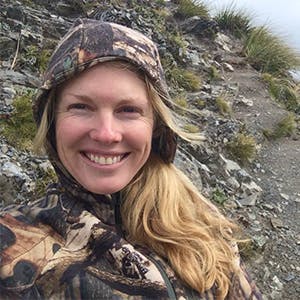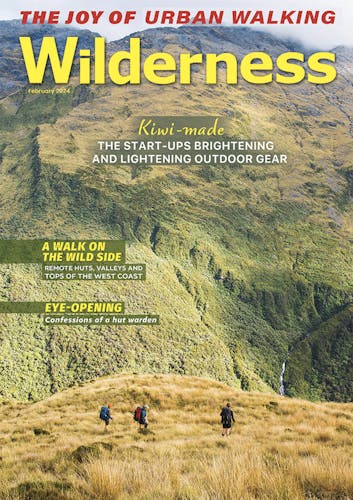Debra and Cody Howell move fast. They met on day two of the Appalachian Trail; 143 days later they were still together. “Speed dating,” Debra called it. She’s an experienced ultralight hiker and lifelong sewer, who had walked Te Araroa and the Pacific Crest Trail and made her own gear. Cody was so impressed by the quality of her quilt he suggested she start selling them. Four years on, the couple has a burgeoning Nelson-based business, Kiwi Ultralight – and an 18-month-old child.
Kiwi Ultralight is one of several ultralight gear cottage industries to have started up in New Zealand. Others include The Very Least Ultralight, Southern Lite Packs, Fiordland Packs and Helium Packs; established repairer Twin Needle is also introducing its own ultralight products. These companies offer innovative, customised gear – primarily packs – made with the latest fabrics. They’re also streamlining designs in keeping with the ultralight minimalist ethos.
Ultralight hiking, or ‘UL’, is hiking with a base weight (the weight of a loaded pack minus consumables such as water, food and fuel) of under 4.5kg. It has been popular in the United States and Europe for about 20 years, and is gathering momentum here.
There’s long been an ultralight cottage industry in the US, says Cody, who is from Ohio. But importing such gear into New Zealand is expensive.
“We came to fill that gap,” he said. “Instead of getting cutting-edge gear from overseas, we can make it right here.”

Kiwi Ultralight began with quilts in 2021.
“You couldn’t buy down quilts that were made in New Zealand,” said Debra, who is a Kiwi. “I wanted more people to be able to experience them.”
Today it’s their primary product, custom-made to a customer’s height and comfort rating with ethically sourced down.
“Our quilt is a globally competitive product,” said Cody. “It’s one of the lightest on the market.”
The same is true for their pack, the Tui 42, a custom-size frameless pack that weighs 420g and comes in a variety of unique patterns printed on HyperD 300.
The company’s product range also includes bush cloths, fitted sheets for DOC hut mattresses, sleep pads – and tents. Its first run of the Moa one- and two-person tent, made with Challenge’s new Ultra TNT fabric, sold out. Kiwi Ultralight is one of a handful of companies worldwide using the fabric. And it’s the only company making ‘the big three’ – packs, shelter and sleeping bag/quilts – in New Zealand.
Debra and Cody want to make as much as possible of their own ultralight set-up available to Kiwis. Their products also maintain a low environmental footprint – treading lightly on the planet is a core value of ultralight hiking – and they avoid disposable packaging and single-use items.
Debra, a former civil engineer, does much of the design and construction. “On my phone I have a list of things I’d like to design,” she says. “There’s just not enough time in the day.”
The Very Least Ultralight’s Kadi and Cameron Fedde also started by making their own gear, as did Southern Lite’s Luke Sergent. Kadi and Cameron couldn’t afford an ultralight tent and their thru-hiking packs lacked the features they wanted, so they made their own using Cameron’s mother’s sewing machine. Sergent began by upcycling a pair of old jeans into bike bags, then moved on to hunting and tramping packs.
Cameron and Kadi hail from Colorado. Like Cody from Kiwi Ultralight, they are well-versed in US cottage industry gear.
“We bought a simple pattern from Bag Buff and made a basic backpack,” says Kadi. “From there, we thought ‘we can make this better, we can change this, we can add that’.”
The newlyweds arrived here in 2020 and spent 18 months travelling around, tackling the Great Walks and Te Araroa – and sewing from their van. Their tent held up, and their vibrant packs were noticed. Realising there was a market for their ‘trail flare’, in mid-2022 they started taking orders.

The Very Least Ultralight makes 35l and 50l packs and 20l fastpacks, all sized for carry-on. Packs are made in Christchurch, primarily using Dyneema composite fabric (DCF), but also Challenge Ultra for ‘hardier’ customers – rock climbers, mountaineers, para-skiers.
The 35l and 50l packs have frame stays, hip belts and variable load-lifters. All packs offer modular components, such as a phone pouch that clips on and turns into a bumbag in camp. Similarly, the straps are universal. Says Kadi: “You can remove the bottom straps, you can put them on the top if you need more compression, or take them off entirely.” These were features they couldn’t find on mainstream packs.

Cameron is an electrical engineer, and Kadi worked in telecommunications. The couple has skills that have proved transferable to the cottage industry: not least, for learning what customers want.
“We’ve had a full range of folk, but most people know what they want and what features they need,” says Kadi. “We get a lot of fastpackers.”
Cameron is a trail runner and fastpacker, and the company’s prototype fastpack, the Ridge Run, is their biggest seller.
They’re no longer sewing solely from the van, but future projects, such as a tent using Ultra TNT, will soon be on hold as they’re expecting a baby. Although there’s little communication between them and the other brands mentioned here – most do follow each other on social media – they’re supportive of Kiwi Ultralight getting in first with the Moa.
“I dream of one day bringing all our competitors together for the weekend to showcase their gear,” Kadi said.
She and Cameron are also considering creating children’s packs and nappy bags.
“Our primary purpose is to make cool, colourful things for people,” said Cameron. “We want to keep it affordable – and get you out there with the minimum you really need.”
While The Very Least Ultralight’s niche is fastpacks, Southern Lite’s is the 85l.
“Packrafters need bigger packs, and hunters like bigger packs for carrying meat,” says Sergent. “Also adventure racers, so they can just throw everything in.”
World champion adventure racer Nathan Fa`avae has a Southern Lite. So does rogaine legend Chris Forne. Sergent’s customers are mostly ‘proper full-on adventurers’. They’re often heading off-track and want super-tough, ultralight gear that will last. “The people who buy my packs have been using packs for years,” he says. “They want something simple, no frills.” No dangly bits that can get snagged or mesh that can rip bush-bashing.

Sergent is originally from the UK and has been making his own gear for years. That morphed into making gear for friends. Then three years ago, the former arborist turned handyman “decided to give it a proper go”, quit his job, moved to Kingston, set up a studio in his garage and went full-time.
Sergent’s intention was to focus on bike packs, “but then I got inundated with people wanting backpacks.”
The majority of his packs are bespoke, and he has an extensive range of fabrics to choose from, including Challenge Ultra 800.
“I use the best fabrics I can get, whereas a lot of the mainstream stuff is nylon or polyester, which is nowhere near as strong,” he says. “My packs are made to your back size as well, so you’re not going to be between sizes. You’ll get a perfect fit.”
Increasingly, his customers include alpine guides and mountaineers, rescue teams and DOC staff, as well as thru-hikers.
Like The Very Least Ultralight and Kiwi Ultralight, which also began around the time of the pandemic, Covid wasn’t a factor in Sergent’s decision, but he says it probably helped. With the push to be outside and international borders closed, people were pulling their old canvas packs out of the closet and updating. Today, he struggles to keep up with demand and has taken on another sewer.
“It’s all about seeing my packs out there, being used on epic adventures. That’s the main reason I enjoy what I do.”
Another newcomer to ultralight is Christchurch company Twin Needle, which started making ultralight gear about a year ago to provide products for customers it was already servicing with repairs.

Twin Needle is best known among the outdoors community for giving new life to old gear – about 400 items are repaired each month – but the company also manufactures and supplies the defence force and the police, and has had its own hard-wearing product range for a decade.
“Knowing where things fail got us into making things that last,” says owner Jonathan Reid.
The shift to ultralight was partly because of a marked increase in repairs for thru-hikers. Issues were generally associated with webbing and buckles on a cross-section of packs.
“The last couple of years we’ve really noticed the number of repairs we’re doing for people walking Te Araroa,” says Reid. “We thought, here’s a customer who knows about us who we aren’t providing a product for.”
Twin Needle has since introduced two ultralight packs, the 33l Kea and the multi-day 55l Tuke, made from X-Pac and Cordura. Both draw on the company’s specialisation in tactical set-ups or MOLLE (modular lightweight load-carrying equipment).
“The Tuke is a base pack that has the ability to add a modular system to it – you can add pouches to the front, to the hip belt, a water bottle to the straps,” says Reid. “It gives customers the opportunity to look at what trips they’re doing, and how to build the pack in the right way.”
Twin Needle has also designed two 3 x 3.5m tarps in different grades of sil nylon, with hunters the biggest buyers to date.
The company’s foray into ultralight is measured – Reid says they will continue to develop and test products extensively before releasing anything new. “There are opportunities to do more, it just depends on how we grow.”
Why the focus on making packs? Partly it’s because ultralight hikers are encouraged to buy their pack last, when they’ve streamlined their kit and know exactly what’s going inside. Kiwi Ultralight and The Very Least Ultralight say this forces walkers to carry what is needed and no more, aspects considered best practice among ultralight hikers.
“Otherwise it can be tempting to just fill it up,” says Cameron.
If you’re an ultralight hiker who carries extra weight at times – such as a packrafter or hunter – a bigger pack offers versatility.
“You can just roll down the top when you’re carrying less,” said Sergent, who regularly goes on day walks with his 75l.
It’s important to know what you want the pack for and which features are required, especially with custom-made.
The benefit of a frameless pack is that it’s lighter (and costs less), allowing walkers to move faster. It also forces people to learn to pack thoughtfully and to use the gear inside as the frame. (Kiwi Ultralight has a section on their website on how to pack a frameless bag.)
Sergent says that if 10kg or more is regularly carried, he’d recommend a framed pack because it allows for better weight distribution. “The other advantage is you can tighten the hip belt, release the shoulder straps a bit and get airflow on your back.”
There are a few other considerations to keep in mind. Returns policies differ between companies, particularly when it comes to bespoke products. The focus can be on communication in the lead-up, so be sure to iron out any uncertainties before production.
Lead times vary, from one to two weeks for Kiwi Ultralight, to three to four weeks for The Very Least Ultralight and Twin Needle, and eight to ten weeks for Southern Lite.
Price-wise, you’ll be paying more than off-the-shelf, but not significantly more, for gear that’s custom-made to fit you. Then there’s the feel-good factor of supporting small, eco-friendly companies using cutting-edge designs and fabrics generally not used by mainstream brands.
“You just can’t buy the products we’re offering from big-box stores,” says Debra.








